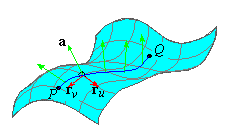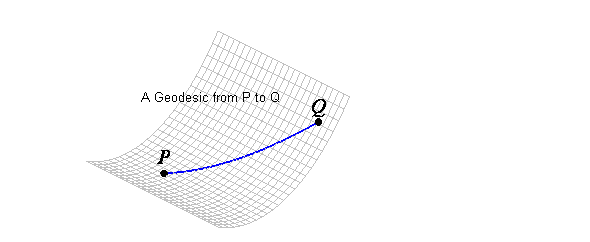DIFF GEOM: Geodesics
The material in this chapter brings us very close to an extremely important
field of mathematics known as Differential Geometry. The "DIFF
GEOM" material at the end of this chapter and in a few places in chapter 5
comprises an introduction to this extremely important field. The
"DIFF GEOM" material may be omitted completely without compromising
the course, but we felt that such proximity to this important body of
mathematics justified including this material for those inclined to pursue it.
Let's begin with the concept of a geodesic. Suppose that r( u,v) is the parameterization of a
surface and that r( t) = r( u(t) ,v( t) ) is a
curve on that surface. If the acceleration r'' (t) is normal to the surface at each point
on the curve, then r( t) is said to be a geodesic
on r( u,v).
Equivalently, r( t) = r( u(t) ,v( t) ) is a geodesic only if r'' · ru = 0 and r'' · rv = 0. That is, a geodesic does not curve in any tangent
plane to the surface, which means that geodesics are the ''straightest''
curves on a surface. The concept of a geodesic is illustrated by the animation below:
Clicking on the animation will switch to a different view.
EXAMPLE 5 Let r( u,v) =
á cos( u) ,sin( u) ,v
ñ be a parameterization
of the right circular cylinder, and let r( t) = r( t,2t+1) be a curve on that surface. Show that r( t) is a geodesic on the cylinder.
Solution: The expression r( t,2t+1) implies
that u = t and v = 2t+1. Thus, r( t) =
ácos( t) ,sin( t) ,2t+1
ñ , so that
|
r' ( t) =
á -sin( t),cos( t) ,2
ñ and
r''( t) =
á -cos( t),-sin( t) ,0
ñ |
|
Since ru =
á -sin( u) ,cos(u) ,0
ñ and rv =
á0,0,1
ñ and since u = t, we have
|
|
|
|
cos( t)sin( u) -cos( u) sin( t) |
| |
|
|
cos( t) sin( t) -cos( t) sin( t) |
| |
|
|
|
Likewise, r'' · rv = 0·cos( t) -0·sin( t) +2·0 = 0. Thus, r( t) = r( t, 2t+1) is a geodesic on the
cylinder.
Since geodesics are the ''straightest'' curves on a surface, the
shortest distance between two points must be along a geodesic, as is shown below
assuming that the blue curve is the shortest curve on the surface from P
to Q.
This is especially important in applications involving surfaces such as the
surface of the earth or a surface in curved ''space-time.''
For example, if r( u,v) is a parameterization of a
sphere of radius R centered at the origin, then its unit normal n is parallel to r. Thus, a curve r(t) = r( u( t) ,v( t) ) is a geodesic
on the sphere only if its acceleration is parallel to r(t) itself. However, r parallel to its acceleration is equivalent to
for all t (and for some
number l). Let's use this to simplify the derivative of r( t) × r' ( t):
|
|
|
|
r' ( t) × r'
( t) + r(t) × r'' ( t) |
| |
|
| |
|
|
|
Consequently, r' ( t) × r'
( t) is constant and as a result, r(t) must lie in a plane through the origin. Thus, a geodesic on a
sphere is a great circle, which is a circle formed by the
intersection of the sphere with a plane through the sphere's center.
|
|
| Drag the points to change the circle.
(Thanks to Martin Kraus for this excellent applet).
|
EXAMPLE 6 Show that r( t) = r( p, t) is a geodesic on the sphere of radius R centered at
the origin, where
|
r( q,j) =
á Rcos( j) cos( q) ,Rcos( j) sin(q) ,Rsin( j)
ñ |
|
is the latitude-longitude parametrization of that sphere.
Solution: The expression r( p, t) implies
that q = p and j = t. Thus,
|
|
|
|
á Rcos( t) cos( p) ,Rcos( t) sin( p) ,Rsin( t)
ñ |
| |
|
|
á -Rcos( t) ,0,Rsin( t)
ñ |
|
|
It follows that its velocity and acceleration are
|
v( t) =
á Rsin( t) ,0,Rcos( t)
ñ and a(t) =
á Rcos( t) ,0,-Rsin( t)
ñ |
|
Substituting q = p and j = t into the partial derivatives
|
|
|
|
á -Rcos( j) sin( q) ,Rcos( j) cos( q) ,0
ñ |
| |
|
|
á -Rsin( j) cos( q) ,-Rsin( j) sin( q) ,Rcos( j)
ñ |
|
|
results in rq( p,t) =
á 0,-Rcos( t) ,0
ñ and rj( p,t) =
á Rsin( t) ,0,Rcos( t)
ñ . Thus,
|
a · rq = Rcos( t) ·0-0·Rcos( t) -0·Rsin( t) = 0 |
|
Likewise, a · rj = R2cos( t)sin( t) +0-R2sin( t) cos( t) = 0,
which implies that r ( t) is geodesic on the
sphere.
In addition, if r'' is normal to the
surface, then the tangential acceleration of r( t)
is zero and consequently, a geodesic r( t) has
constant speed. For example, the speed of the geodesic in example 3 is Ö5 and the speed of the great circle in example 4 is 1. Since the
speed of a geodesic is constant, the arclength is proportional to the
parameter, and as a result, it is rather simple to obtain an arclength
parameterization of a geodesic.
Check Your Reading: If the earth is assumed to be a
sphere, then which circle of constant latitude is also a geodesic?

